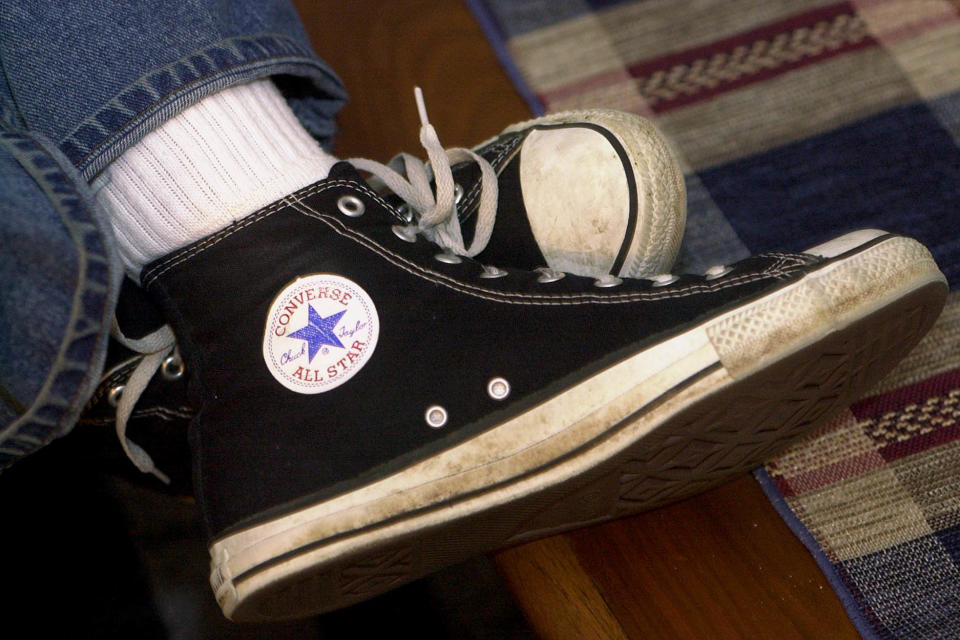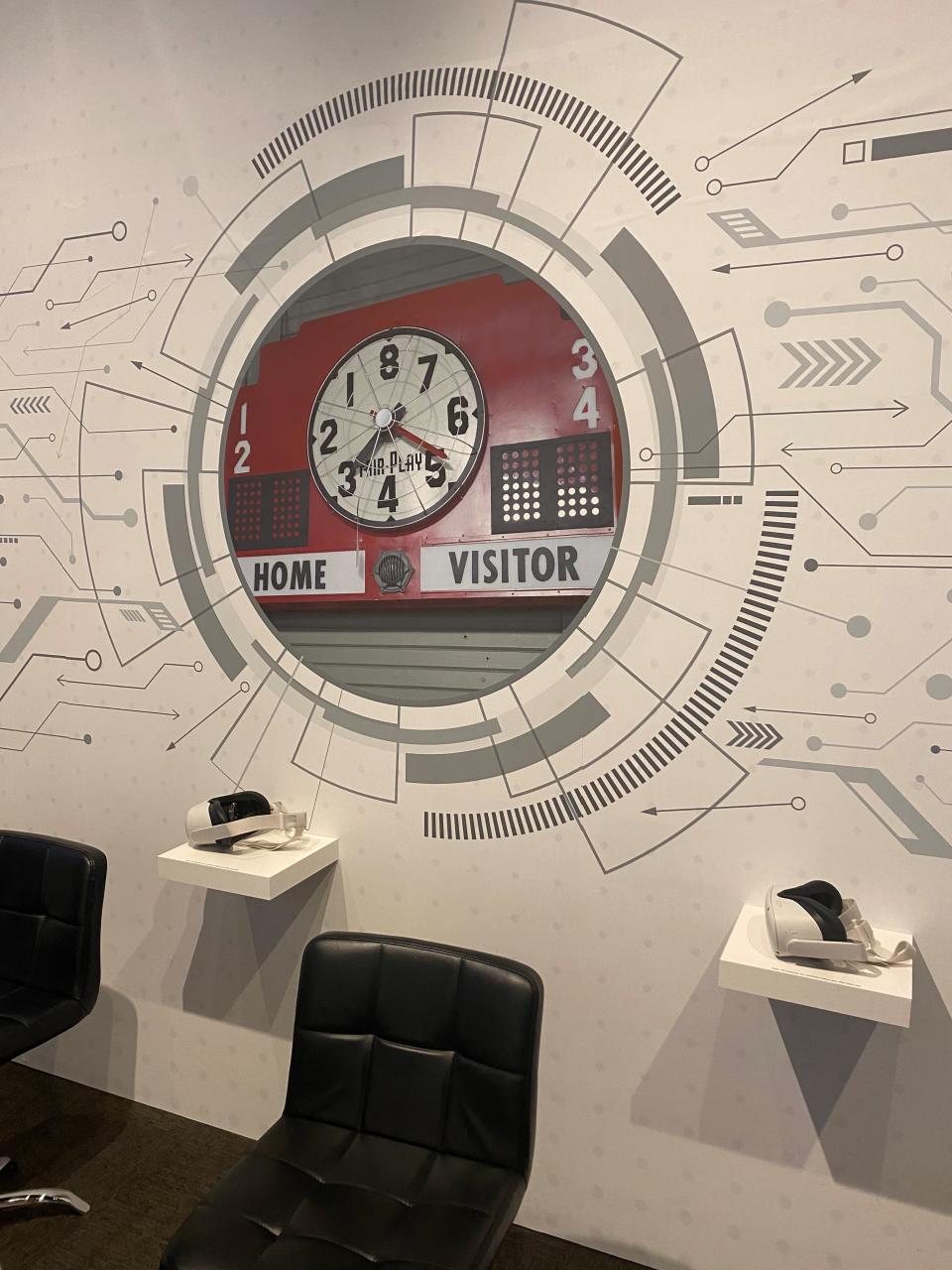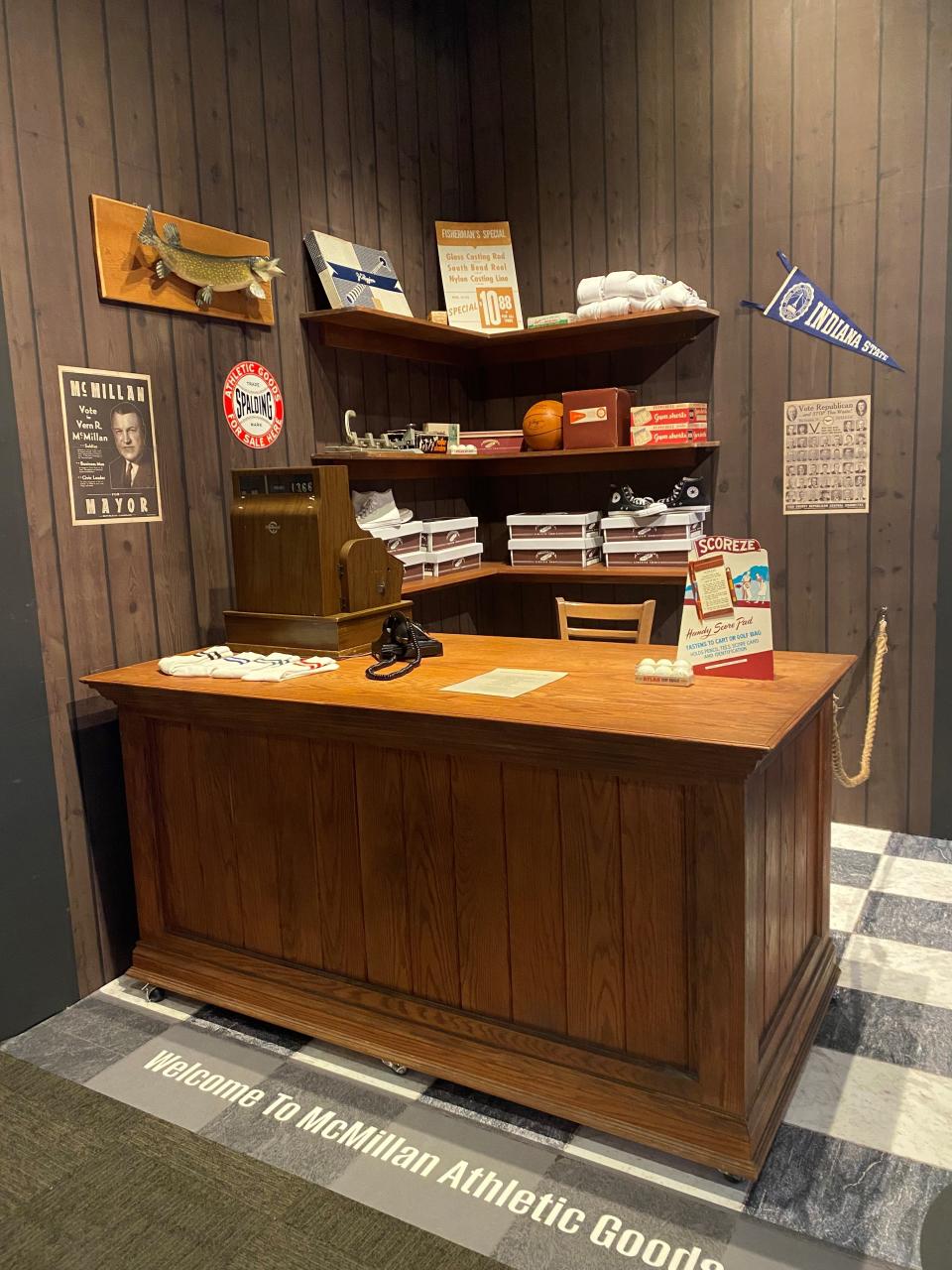Come for the Chucks, find yourself shooting with legends and attending 1941 game at Hinkle
INDIANAPOLIS – We’ve come Downtown for Chuck Taylor and his Converse sneakers, what you call “Chucks,” but somewhere along the way we've made a wrong turn and found ourselves inside a sporting goods shop in Terre Haute. Not to worry, we can get out of there — but give us a few minutes; who doesn’t love a sporting goods store? — only now we’re inside the Hoosier Gym in Knightstown.
Not to worry, etc. and so on, only now we’re racing up the steps of the Vigo County Courthouse on a motorcycle. Or shooting free throws with the best foul shooter in the world. Or inside Hinkle Fieldhouse for the 1941 IHSAA boys basketball championship game.
Hey, there he is. There’s Chuck Taylor in those Converse All-Star sneakers, but why is he handing us a basketball?
Didn’t Chuck Taylor die in 1969?

What’s happening here at the Indiana Historical Society? Every time we turn around we’re in another place, in another time.
What you call “wormholes.”
Wormhole Archive Retrieval Program
Truth is, there was no story here. Which was a letdown, but whatever. Come to the Indiana Historical Society for one of its special exhibits, “Chuck Taylor All Star,” and you’re hoping to get a story out of it but you’ll settle for some sightseeing and one of those garlic buffalo tenderloins you’ve heard about.
From March: Exhibits spotlights Hoosier connection to popular "Chucks" sneakers
You’re walking past pictures of Chuck Taylor the man and glass cases of "Chuck Taylor" the sneaker. The basketball shoe evolved from a miner’s boot to a fashion statement, and this is entertaining, but you're not feeling it enough for a story. What you’re feeling is hunger, and the Stardust Terrace Café is on the Canal Level, and this is what happens next:
To get to your garlic buffalo tenderloin, you’re walking past a booth in the corner selling something or other. Now you’re seeing a room in another corner, you must’ve missed it earlier, and you’re peering through the glass walls and seeing a guy in a chair wearing goggles and doing something with his hands.
Is he shooting a free throw? And is he shooting it underhanded? What you call “granny style.”
You’re hungry, but the café is open for another few hours and the room is here and the guy seems to be having a good time, so you’re walking inside. There’s a sign inviting you to put on a pair of goggles, what you call an “Oculus headset.” It’s saying you’re about to enter a WARP:
Wormhole Archive Retrieval Program.
Maybe there is a story here.
No dead guy’s gonna beat me
Virtual reality has never done much for me. But then, virtual reality has never let me take a shooting lesson from Bunny Levitt.

Maybe you’ve never heard of Bunny Levitt. Probably because you didn’t grow up in Mississippi in the early 1980s, before ESPN — what they call “cable television” — back when you played sports or read about sports or were good and bored. So I was reading about the Harlem Globetrotters, the all-Black barnstorming team that brought along this 5-4 white dude to shoot free throws at halftime. The Globetrotters invited people from the crowd to beat this guy, offering $1,000 to anyone who could do it, and never paid a cent.
Bunny Levitt didn’t miss, see. In 1935, he made 499 free throws in a row, a world record that stood for 40 years.
Forty years later we’re in the WARP room, wearing Oculus goggles, only we’re not in the WARP room anymore. Wait, I know this place. Been here before, to write about a high school all-star game. Remember those paneled bleachers, that gleaming hardwood court, even the sign behind the basket: GO HICKORY All The Way!
This is the Hoosier Gym in Knightstown, and we’re standing at midcourt, and you can almost smell the wax but never mind that because Chuck Taylor is standing in front of us, talking to us. Now he’s introducing Bunny.
Bunny Levitt is not physically impressive, and not just because he’s been dead since 2006. But he’s gripping the ball backward, and he’s throwing it backward — from his knees to the rim — and he’s not missing. Now he’s asking you to try, so you reach for the ball, grip it backward, throw it backward, and watch it clang off the rim.
Look, I once hit 31 free throws in a row at a YMCA in Fairfield, Ohio. No dead guy’s gonna beat me. Give me the ball, Bunny.
It goes in, again and again, only my time with Bunny is up after just three buckets. Nobody wants to give me $1,000, is how it looks to me. What you call “cheapskates.”
Now Chuck Taylor is giving us a lesson in passing the ball, which might not sound cool, other than this: We’re passing it to Sam Richardson, MVP of the Indiana State Sycamores basketball team ... of 1956.
Now Taylor is opening up another wormhole. We’re inside another gym: sloping rafters overhead, light coming through the windows facing midcourt. This is Hinkle Fieldhouse, and we’re watching the 1941 IHSAA boys title game when Washington beat Madison, 39-33. The Hatchets’ Leroy Mangin, old “Hook” himself, is scoring 18 points in his final high school game before going to play for Branch McCracken at IU.
The show ends. Guess it’s time to get that tenderloin.
Doyel: Dave DeJernett and the 1930 Washington Hatchets, pioneers that time forgot
Wait, this guy was real?!?
Remember that booth in the corner, selling something or the other? We’re slowing for a look as we walk past. They’re calling it McMillan Athletic Goods, and you’ve got to hand it to the folks at the Indiana Historical Society — they know how to make it look real, like we’re really in the early 1940s shopping for Chucks ($6.99) or a basketball ($4.99) or roller skates ($2.95).
Why, there’s even a poster on the wall. Political advertisement, looks like. They’re pouring it on thick here. Apparently old man McMillan is running for office in Terre Haute. “Vern R. McMillan,” the sign says. “Mayoral candidate 1942” it says.
Looks sort of real, come to think of it. Let’s read up on this “Vern R. McMillan” character.
Jeepers.

Turns out he was one of the more fascinating people to call Indiana home. He was born in Kansas, played football and ran track for the Jayhawks, but moved to Terre Haute in 1915 to work at his uncle’s bicycle shop. One of the first things he does, who knows why, is drive his motorcycle up the Vigo County Courthouse steps. He didn’t get arrested for that — he got a deal with a local motorcycle company!
Natural-born salesman, this guy. He challenged motorcycles and thoroughbreds to a foot race, set ‘em up so he’d win, got more attention, opened his own sporting goods store in Terre Haute in 1926, and started tinkering with the leather helmets football players were starting to wear. The mouth and nose were left unprotected, so Vern McMillan went into his shop and came up with something revolutionary.
What they call a “facemask.”
McMillan was mayor from 1942-47, shut down Terre Haute’s steamy red-light district, talked Anton Hulman into donating land for some plane runways — what they call “Terre Haute Regional Airport” — and brought the Philadelphia Phillies’ Class B farm team to town for eight years.
Now we’re leaving McMillan’s shop in a daze, walking the polished halls of the museum, finding the exit and heading home in a daze. Didn’t this start with Chuck Taylor? Didn’t this start with a pair of shoes?
It’s a lot to digest, but we have room. Looks like we forgot the tenderloin.
Find IndyStar columnist Gregg Doyel on Twitter at @GreggDoyelStar or at www.facebook.com/greggdoyelstar.
If you go:
The “Chuck Taylor All Star” exhibit at the Eugene and Marilyn Glick Indiana History Center, 450 W. Ohio St., runs through Jan. 27, 2025 and is included with general admission: $15 on site ($13 online), and $5 for kids 5-17. Admission is free each Thursday through July 27. For more, call 317-232-1882 or visit indianahistory.org.
This article originally appeared on Indianapolis Star: Indiana Historical Society's Chuck Taylor exhibit is wormhole to past

